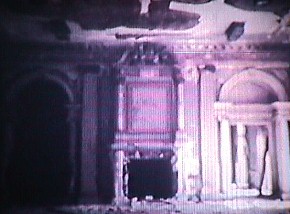2001.01.15
Quondam as hypermuseum
01. continuation of "Lauf Haus der Kunst".
02. lots of new museum (model and plan) play.
03. museum annex development.
04. the working title museum.
05. something to do with the Ryerss Museum.
06. the local acropolis.
08. a solarized "photography" exhibit.
10. IQ as the plan of a hypermuseum(?).
...Quondam as hypermuseum to be the manifestation of designing and practicing (architecture) in cyberspace ideas... Quondam to display an exploitation of data in the digital realm to create entities that (can) only exist in the digital realm.
2001.02.20
Museum Collecting--ideas, collection
Altes Museum
Museum for Nordrhine-Westfalen
Wallraf Richartz Museum
Arts and Crafts Museum
House 10 (Hejduk)
Museum of Knowledge
Kimbell (barely)
Seroux's Histoire
Durand's Recueil
Denkmal plates
1880s engravings
Working Title Museum
Museum Annex
Acropolis Q
seeking precedents... ...finding inspiration
2001.07.17
virtual museum commentary
Virtual museums, that is, those museums that exist within the cyberspace of the Internet, travel to individuals rather than having individuals travel to them. The virtual museum in its fundamental 'approach' is exactly opposite that of a real museum.
Virtually anyone can now create a virtual museum, and perhaps the more a virtual museum is unlike a real/traditional museum the better.
Perhaps someday someone will write a book entitled Virtual Standards.
Quondam's collection, moreover, is unlike any traditional museum collection because it continually generates its own growth. Digital data has the inherent ability to spawn more and more new digital data.
In Quondam thinking, content is preferred over display.
2001.07.21 11:32
Piranesi, Duchamp and Mustard
Use your imagination when it comes to the subject. The object is to be a self-publishing museum.
2001.08.13
Museum Collecting archive
A collection of the digital images of the various museums that will be featured in Museum Collecting.
A sampling of some unusual aspects...
2001.08.18 15:32
Happy Saint Helena Day
Then I took R. to Ryerss Mansion and Museum in Burholme Park. I've 'rediscovered' this place last December. It's one of those places you pass all the time, but never bother to look inside of. It's my new favorite place. I describe it as "'Venturi Shops' 100 years ago" because the VSBA 1995 exhibit Venturi Shops unwittingly reenacts exactly what Ryerss Mansion and Museum is, namely, an exhibition of things bought during excursions of India and the Far East (albeit 100 years ago). Because Ryerss is actually a museum of someone's shopping, there is an interesting Koolhaasian reenactment manifested here as well. Additionally, I tell R. my new typological interest is houses that morph into museums, of which Ryerss Mansion is a prime example of as well.
| |
2002.06.21 11:55
Re: genetic architecture
The forms don't bother me, and the method (i.e. using CAD, etc. software) doesn't bother me. What I think is wrong, however, is the hype, specifically, in this case, that all this is somewhat more authentic because it is more natural, more 'genetic' and therefore more correct. Where, in reality, it is all just more arbitrary.
I remember back in school where there had to be a reason for ones design, and the worst thing possible to be criticized for was for being arbitrary. I more or less had to comply then, but I know better now--for example, I venture to guess that most architectural clients are almost fully arbitrary, as is almost all of the architecture being built today--how else would you explain the way things really look out there.
arbitrary 1: depending on choice or discretion; specif : determined by decision of a judge or tribunal rather than defined by statute 2 a (1) : arising from unrestrained exercise of the will, caprice, or personal preference : given to expressing opinions that arise thus (2) : selected at random or as a typical example b : based on random or convenient selection or choice rather than on reason or nature 3 a : given to willful irrational choices and demands : IMPERIOUS : characterized by absolute power or authority : DESPOTIC, TYRANNICAL
There really are no statutes of architectural design, except for building codes, and even they are not beyond being side-stepped, and there certainly is no definitive common ground as to what is good design and what good design isn't. So-called 'Genetic Architecture' is no better or worst an any other architecture available; right now it's just more trendy.
Teaching designers/architects (how) to be arbitrary might just be the real natural, rational thing.
2002.08.08 20:10
axis of synagogues
Ahavath Israel Synagogue [Kahn's first independent commission] was/is situated within a typical northern Philadelphia block of row homes where it is indeed atypical for a synagogue to be in the middle of the block. Nonetheless, Ahavath Israel is indicative of the large Jewish community living in northern Philadelphia, particularly along the North Broad Street corridor, during the first half of the 20th century. Although a large building within its immediate context, Ahavath Israel represents the smaller type of synagogue intended for more informal daily use by its neighbors.
By the 1950s, North Philadelphia Jews began moving out to the suburbs directly north of Philadelphia.
2003.02.04
Unthinking an Architecture
Volumes of UaA may include Remove, Lacunae, Nimiety, Sagacity, Chronosomatics, Atypical, Domestic, but not necessarily in that order. The order really doesn't matter. UaA as a kind of Cremaster Cycle, a multi-part vehicle for product generation and placement. There is also the notion of being purposefully obscurant, thus allowing all kinds of non sequiturs and an overall lack of necessary cohesion.
...(obscure) intellect to be the main, albeit, "not there" character. Have the audience say, "It's fascinating, but I really don't get it."
...not sure if Epicentral gets involved.
| |
2003.02.06
ideas
The introduction to The Museum as Muse is very good and I should write my own long essay as to how I too have been actively "artistic" with regard to museums... This essay is perfect for Unthinking an Architecture. The Hubert Damisch "A Very Special Museum" also needs to be addressed in terms of a/my museum of architecture.
2003.02.27 11:02
Re: WTC design study
Now I get it. The whole WTC design event so far is more than anything a museum of lobbies(?).
Museum Collecting Point One: Monument Hysterique.
Ms. Curious:
"So what do you do?"
Mr. Nimiety:
"I collect museums."
2003.03.11
ideas
Museum Collecting Point One: Monument Hysterique
Begin Unthinking an Architecture with "Atypical" which features unique ichnographic capabilities; the opportunity for play and unbridled creativity; the venue for a new slapdash Ichnographia (Campus Martius). ...what other themes and texts?... ...maybe 'new dexterity' as in doing (new) things atypically.
2003.04.02 10:53
Re: changing stuff that really is life
Among the next projects to keep mostly incomplete:
chapters of Unthinking an Architecture
1. Atypical
2a. Lacunae
2b. Remove
3. Sagacity
4. Nimiety
5. Reenactionary Architecturism
2003.04.15 06:01
Unthinking an Architecture
1. Atypical
2a. Lacunae
2b. Lapidary (was Remove, but Remove was removed to Lacunae)
3. Sagacity
4. Nimiety
5. Reenactionary Architecturism
2003.06.26 00:27
so what then is architecture?
Architecture is product imagination, and I believe human imagination reenacts corporal physiology. This is not to say that architecture is synonymous with the body, nor that building be identical to bodies.
The notion that touch is the first sense to come about (and really what sense could have preceded it?) provides a firm place to start (thinking about beginnings).
The notion of female hardness and male softness suggests that the typical notion of male hardness and female softness is a superficial perception at best. I'm suggesting looking at the design of the human male and female body the way it really is, as opposed to the way centuries of cultural patrimony would rather it be percieved to be. It's an issue of seeing design for what it really is.
I know my thinking is provocative, but hardly rambling, and the most pseudo things in this thread are all the pseudo names.
I've learned to trust my perceptions regarding design. For example, all the architectural theorists that have ever said something about Piranesi's Campo Marzio (including the current dean of Princeton architecture) have never looked enough to find what I have found, which is that there are indeed two versions of the large plan, thus making me someone that discovered a heretofore unknown Piranesi--not exactly like discovering a lost/unknown Michelangelo, but not far away from it either.
| |
2003.07.14 14:47
Re: houses saved by deconstruction or HABS
Cabinets and Museums--virtually the same exact thing. Think about it.
2003.09.04 19:10
Re: CFP: Museums and the Web 2004
... There's nothing fancy about the display, but I like the effect of "going through a museum" on a day by day, as opposed to room by room, basis.
[Thinking just now:] a calendrically mnemonic museum design.
2003.10.06 14:11
2004: Philosophy of Architecture/Architecture...
from the call for papers:
"In particular the conference will examine contemporary architecture (so-called postmodern or deconstructive architecture), which as a practice seems to perform the insights of postmodern theory, and the architecture of the museum and the museum of architecture and the Architectural Archive. Here the conference would like to explore debates around the creation of museum spaces and the relationship between collections, interpretation, meaning and space."
from the back cover of Lotus International 35 (1982):
The museum of architecture
It's no longer possible for a contemporary architect to resolve the complex thematic of the museum in the typological conception of a building. Museum architecture, on deeper investigation, is transformed into a reflection on the museum-making of architecture itself.
We can find the prototypes of this phenomenon in the first collections, in the house-museum, in the first archaeological excavations, limited phenomenon which gradually spread until they became a program of exhibition organization throughout the world with the great exhibitions of the start of the century.
Today, in fact, they look to us as a colossal project of museum-making, even if with the aim of instructing. But the world which is given back to us like a still life in the museums, all of the works, the image, the production of varied ages and places is only a universe of melange, a metaphor of the living world the disorder of which is brought back to mind in the "magnificent chaos of the museum."
[The entire issue of Lotus International 35 is devoted to "the museum of architecture" theme.]
2004.04.19 15:23
Re: If you build it, then it's likely to be torn down.
Last time I was in Eva Stotesbury's Ballroom, the place looked like this:

All the art of the Metropolitan Museum was in this place during World War II.
Museum [in not] peace.

2004.05.08 15:20
Dis: content
Received Content (the new Koolhaas book) in the mail a couple hours ago. Looked through the whole thing page by page once so far. After doing that I realized that Content inside looks exactly like i-D magazine of 20 years ago. The only difference is that i-D is still better at its delivery of content.
[i-D, the worldwide manual of style, a sort of 'underground' fashion magazine that started coming out of London October 1980, and is today more a mainstream, albeit still 'avant garde' fashion magazine.]
I still have my collection of i-Ds from the mid-1980s, and I'll keep on keeping them (especially since they are still so up to date). I doubt I'll still own Content 20 years from now, however.
[reenactment note 356.38976 -- remember how Koolhaas' delivery of Content essentially reenacts i-D's delivery of content 20 years ago. I wonder if Koolhaas even knows he was following the "manual of style"? I seriously doubt it. Just thought of a new working title: From Euphrates Cat To Copy Cat.]
The "Editor's letter' of Content by Brendan McGetrick suggests that "remaining at home [is] torturous," thus it is obvious the editor here doesn't know that remaining at home is the grand luxury of being virtually famous.
|